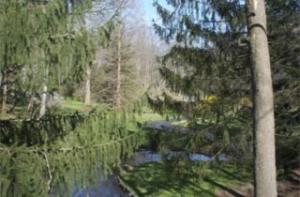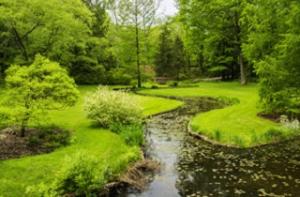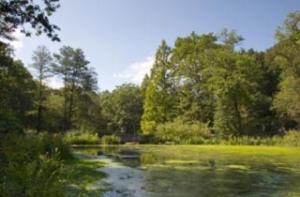Moggy Hollow



MOGGY HOLLOW AT LEONARD J. BUCK GARDEN
The Wisconsin glacier started its southern movement about 50,000 years ago. This is a relatively short time geologically when you consider that the red shale that underlies our area was laid down as sediment about 185 million years ago during Triassic times. The trap ridges, now the Watchung Mountains, boiled out of the earth as molten lava and solidified about 175 million years ago. The Wisconsin ice sheet reached the Paterson - Little Falls area approximately 15,000 years ago, reaching its terminal moraine, or most southern position, about 3,000 years later. As the ice sheet melted and started to retreat towards Paterson, its progress was much faster, taking only about 1,000 years. Lake Passaic ceased being a lake about 11,000 years ago, followed by post-glacial lakes. Even today we have Great Piece Meadows, Hatfield Swamp, and the Great Swamp as shallow reminders of that past glacial era. When the Wisconsin ice sheet reached the gaps at Paterson and Little Falls and sealed them, water in front of the ice accumulated as a lake. The lake formed was very small and shallow since the overflow was over a low divide. This drainage basin may have had its outlet at Little Falls, and then through the Short Hills gap- As the glacier continued its southern course, it closed the Short Hills gap through the Watchung Mountains. This was the original course of the Hudson River until erosion further north changed its course to today's location. With the Short Hills gap closed by ice, the water before the glacier filled the basin to a depth of approximately 160 to 200 feet until a new outlet was reached at Moggy Hollow. As the glacier retreated, it plugged the pre-glacial outlet at Short Hills with drift, and Moggy Hollow remained the outlet of the lake. The lake grew in size as the ice retreated. At its maximum Lake Passaic was about 30 miles long, 8 to 10 miles wide, 240 feet deep at maximum depth, and 160 to 200 feet deep over wide areas. When the glacier retreated north to the Paterson - Little Falls gaps they were opened, and the lake drained through them, thus ending the overflow through Moggy Hollow. In the years necessary for the water to wear down the hard rocks in the gaps to their present level, there were post-glacial lakes in the basin. The longest-lived of these was the one that occupied the area of The Great Swamp northwest of Long Hill, which persisted while the overflow was cutting a narrow gorge at Millington. The elevation of this lake at the outset was about 320 feet above sea level, but as the outlet was slowly cut down to its present level of 221 feet, the lake was drained. "Totem Pole Museum, November 1959". (revised, 1991) The Moggy Hollow National Landmark is owned by the Upper Raritan Watershed Association. It is adjacent to the Leonard J. Buck Garden in Far Hills, New Jersey.
E-mail the Horticulture Dept. with any questions or comments.
